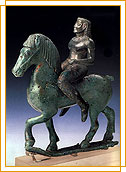The charioteer
The successful charioteer should lead his chariot without swerving
-something  difficult
especially regarding the tethrippon- to know well
how to use the whip and to hold the reins safely, so that
he could avoid collisions or falling from the chariot in the
curve. During the contest, the main concern of the charioteer
was to take advantage of the inner side of the hippodrome,
in such a way as to cover the minimum distance possible. According
to the representations on pots, the riders were naked and
without saddle and stirrups, holding the reins and the whip. difficult
especially regarding the tethrippon- to know well
how to use the whip and to hold the reins safely, so that
he could avoid collisions or falling from the chariot in the
curve. During the contest, the main concern of the charioteer
was to take advantage of the inner side of the hippodrome,
in such a way as to cover the minimum distance possible. According
to the representations on pots, the riders were naked and
without saddle and stirrups, holding the reins and the whip.
The charioteers were not the owners of the horses, but they were paid by the owners to ride their horses on their behalf. The owner of the horse was declared the winner and received the kotinos -the wreath from the sacred olive-tree in Olympia- as a prize, while the rider or the charioteer was crowned with a woolen stripe. For this reason, there have been cases where women were crowned Olympic victors (Cyniske) or even children and cities (Argos, Thebes). The animals that won in the contests were also crowned with a woolen stripe and they received special honors.
Famous charioteers were Antikeris from Cyrene, Karrotos the charioteer of the king of Cyrene Arkesilaus, Hromios of the tyrant of Syracuse Hieron, Fintis the charioteer of Agesias from Syracuse and the Athenian Nicomachus the charioteer of Xenocrates from Acragas.
|
